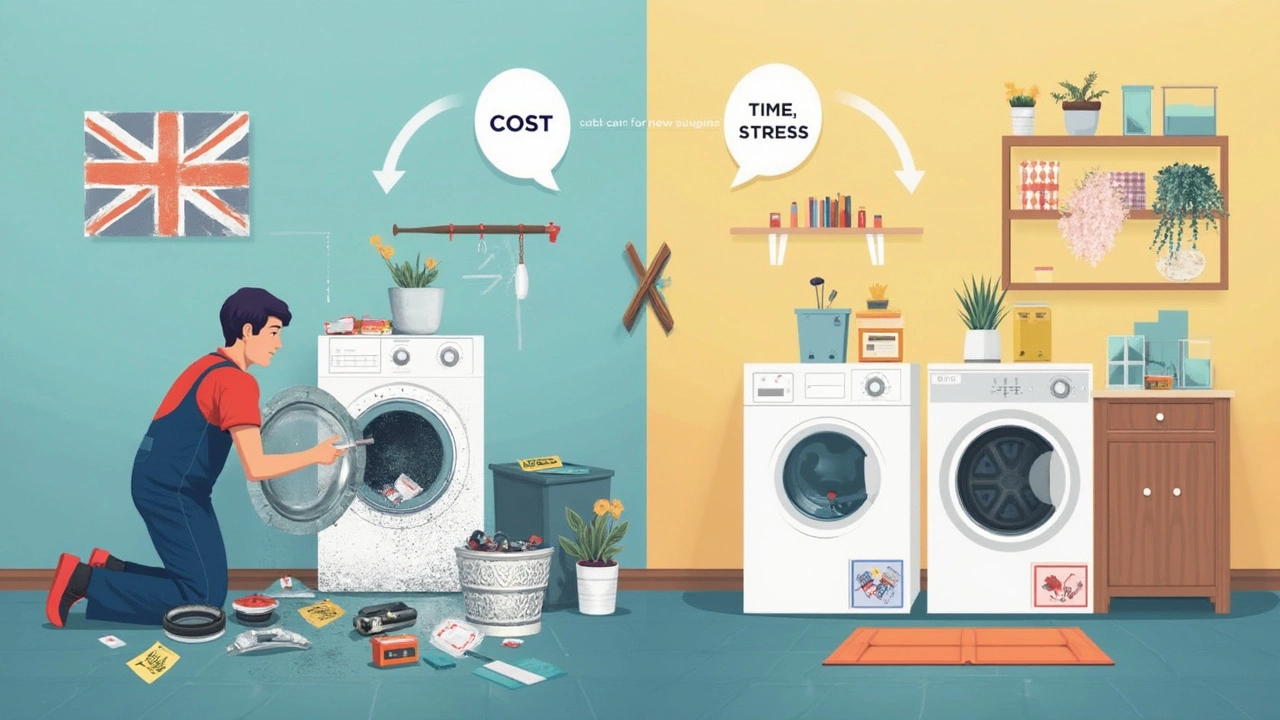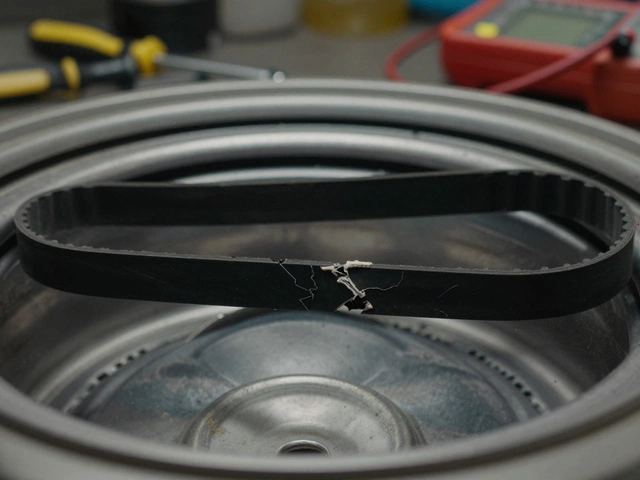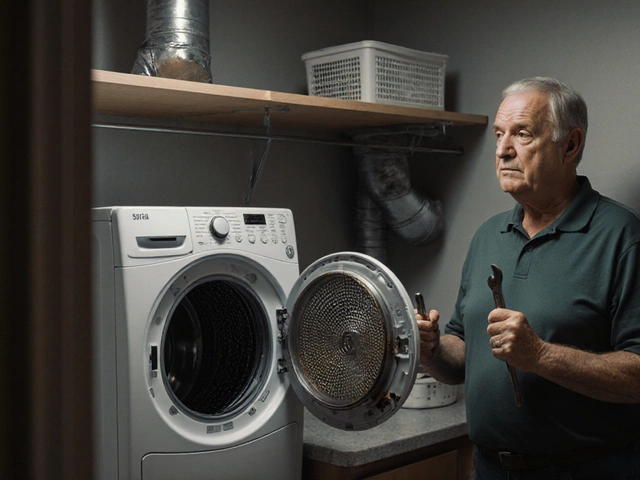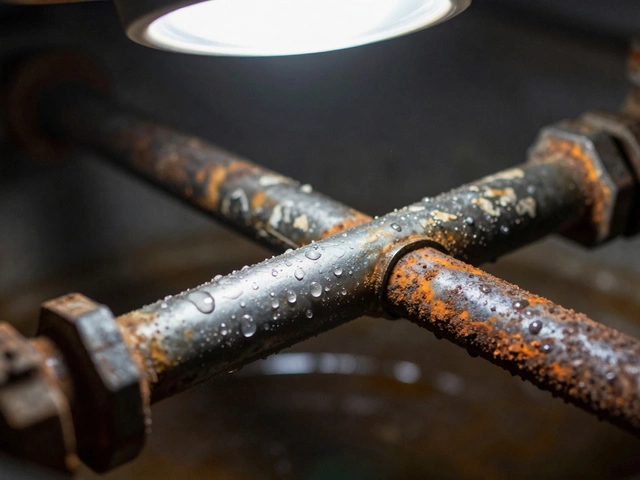A 10-year-old dryer isn’t exactly ancient in appliance years, but it’s no spring chicken either. If you're standing in front of a machine that suddenly stokes out, your wallet's first impulse might be to fix it and hope for the best. But is that actually smart?
After a decade of tumbling towels, most dryers start showing their age. Common issues pop up like burnt-out heating elements, dragging drum rollers, weird noises, or dead controls. Some fixes are quick, like replacing a busted thermostat for under $40 with a cheap part. Others, like swapping out a motor or control board, can run over $200 with parts and labor.
The trick is knowing where to draw the line. Fixing a minor issue is one thing. Dropping a chunk of cash on a part that won’t make the machine last much longer? That’s another story. Before you call in the repair tech, it helps to know how long dryers usually live, what parts go out first, and whether your dryer’s got more good years left—or if you're buying time on a dying machine.
- Why Dryers Break Down After 10 Years
- What Typical Repairs Actually Cost
- Signs You Should Just Get a New Dryer
- When Repair Is Still a Good Bet
- How to Make Your Next Dryer Last Longer
Why Dryers Break Down After 10 Years
Dryers aren't built to last forever, and hitting the 10-year mark is when most start showing their age. The average lifespan of a household dryer is somewhere between 10 to 13 years, depending on how often you use it and how well you've kept up with cleaning the lint trap and vents. Manufacturers don't hide this—they design most machines for that rough window.
Here's what’s usually wearing out under the hood after a decade:
- Heating Elements – The part that actually dries your clothes gets brittle and burns out from constant heating and cooling.
- Drum Support Rollers – These let the drum spin smoothly but flatten or seize up after thousands of cycles, causing loud rumbling.
- Belts – If the drum stops turning or sounds off, the drive belt is often the culprit, and rubber just doesn't last forever.
- Thermostats & Sensors – Modern dryers use a bunch of these, and they can fail slowly, leading to overheating or damp clothes.
- Motors – It’s rare, but once the motor gives out, repair costs shoot through the roof.
- Control Boards – Digital models are handy but more vulnerable to pricey failures due to power surges or just old age.
Check out this quick rundown of how common major part failures get after 10 years:
| Part | Chance of Failure (10+ years) |
|---|---|
| Heating Element | High |
| Drum Rollers/Belt | Moderate to High |
| Thermostat/Sensor | Moderate |
| Motor | Low to Moderate |
| Control Board | Moderate (especially in newer models) |
All those moving parts and heating cycles take a toll, especially if you're drying heavy loads or forgetting to clear out lint. Lint build-up is actually a big deal: not only does it strain the machine, but studies from U.S. fire prevention agencies link thousands of house fires every year to clogged dryer vents or filters.
So, when you’re asking if a 10 year old dryer is worth fixing, remember it’s usually running on borrowed time. One repair might fix the problem this month, but it won’t hit reset on everything else that’s getting worn out underneath.
What Typical Repairs Actually Cost
Let’s be real: no one loves surprise repair bills. When your 10 year old dryer croaks, you want a rough price tag before you even call the repair shop. Over the last few years, the average dryer repair in the US has been between $140 and $300, and that’s just for the basics—not major surgery.
Simple stuff—like replacing a broken belt or a busted thermostat—can usually be done for under $100 if you’re handy. If you need pro help, expect to pay more for labor than the part itself. But when core components like the motor or control board go, you’re staring down a much bigger bill.
- Heating element: Parts alone can run $40 to $120. Add $60 to $120 for labor if you don’t DIY.
- Drive belt: Around $20 for the belt, but expect $80-$150 total with service.
- Drum rollers/support wheels: Parts cost $10 to $30 each, labor can double or triple that.
- Motor: Easily $140 to $250 for the part, plus $100+ labor.
- Electronic control board: Up to $220 for just the part, and you pay labor on top.
Here’s a quick cheat sheet for what repairs on a 10 year old dryer might set you back:
| Repair Job | Part Cost | Installed Cost |
|---|---|---|
| Thermal fuse | $10 - $30 | $60 - $110 |
| Heating element | $40 - $120 | $120 - $240 |
| Timer/control board | $70 - $220 | $150 - $350 |
| Drum support rollers | $10 - $30 | $80 - $180 |
| Motor | $140 - $250 | $250 - $400 |
| Igniter (gas dryers) | $20 - $50 | $90 - $170 |
Some fixes don’t make sense on an older machine, especially if you’re paying more than half the cost of a new dryer (which typically starts around $500 for entry-level models). Bottom line: Do the math before deciding if that repair call is worth it, or if it’s time to start dryer shopping.

Signs You Should Just Get a New Dryer
Sometimes hanging onto a 10-year-old dryer just doesn’t make sense. Why? Appliances do have an expiration date. The average lifespan for most dryers sits around 10 to 13 years, according to appliance industry data. If yours is already throwing fits, that’s a clue it’s hitting the end of the road.
How do you know it’s time to let go? Watch for these signs:
- Repair costs climb over half the price of a new machine. If a big fix, like replacing a heating element or motor, runs you $300 and a decent new dryer goes for $500–$700, that’s not a smart money move.
- Breakdowns keep piling up. If you’re calling the repair tech more than once a year, you’re basically living on borrowed time and borrowed money.
- Drying takes way longer than before. If a full load that used to be dry in 45 minutes now takes two cycles, the guts of the dryer might be too worn out to fix cheaply.
- You spot obvious safety warnings—like a burning smell, frequent overheating, or a tripped breaker. These can be serious fire risks, especially in older dryers with worn wiring.
- Finding replacement parts is getting tough or expensive. Some brands stop making parts for old models, which makes future repairs a pain, if not impossible.
Take a look at some real-world numbers to help put it in perspective:
| Typical Dryer Age | Annual Repair Odds (%) | Common Repair Cost ($) | New Dryer Cost Range ($) |
|---|---|---|---|
| 0-5 years | 3 | 60-120 | 400-900 |
| 6-10 years | 9 | 120-300 | 400-900 |
| 10+ years | 16 | 150-400 | 400-900 |
If your 10 year old dryer is on the wrong side of these numbers or is riddled with any of the issues above, hanging on isn’t worth the hassle. You might be better off biting the bullet now, saving yourself emergency laundry runs and headaches later.
When Repair Is Still a Good Bet
Before you start shopping for a replacement, you should know there are times when fixing your 10 year old dryer still makes perfect sense. Not every problem is a deal breaker—some fixes can squeeze a few more good years out of your dryer without emptying your wallet.
What kinds of repairs are considered "worth it"? If your dryer only needs a part that’s cheap and easy to swap—think belts, fuses, door switches, or a basic thermostat—you’re probably looking at a fix that costs way less than buying new. Even a heating element, which is a pretty common failure, usually runs under $100 for parts if you’re a do-it-yourself type.
It also matters how the dryer has been treating you so far. If it’s been mostly reliable, doesn’t show signs of bigger trouble like a rattling drum or burning smell, and your energy bills haven’t spiked, then repairing a single part is a no-brainer. Here are some clear green lights for considering repair first:
- Repair cost is under half the price of a comparable new dryer (which, according to home appliance groups, is about $600-$800 average for mid-range models in 2025)
- No major rust, mold, or damaged drum parts anywhere on the machine
- Dryer issue is a well-known, manageable fault—like a worn belt or blown fuse—not a complicated failure like the control board
- The dryer hasn’t needed more than one repair in the last two years
Here’s a quick comparison of common repair costs versus buying new:
| Issue | DIY Repair Cost | Pro Repair Cost | New Dryer (Avg. Retail) |
|---|---|---|---|
| Dryer belt replacement | $15 - $40 | $100 - $150 | $600 - $800 |
| Thermal fuse | $10 - $25 | $80 - $130 | |
| Door switch | $15 - $30 | $90 - $140 | |
| Heating element | $40 - $90 | $160 - $250 |
Every machine is different, so it’s smart to check your model’s parts availability—a few big-name brands still churn out replacement parts even after a decade, which keeps repair realistic. Finally, if your dryer matches other appliances and you care about your home’s look, repairing it might just save you the headache of trying to match colors or profiles, which is trickier with older units.

How to Make Your Next Dryer Last Longer
If you're tossing around the idea of buying a new dryer, you’ll want to make sure it lasts longer than your last one. Most folks expect a dryer to run around 10 to 13 years, but with just a little effort, you can stretch that timeline by several years.
The biggest dryer killer is clogged lint. Not just the screen—the vent hose too. A 2023 Consumer Reports survey found that 27% of dryer breakdowns were caused by poor airflow. You can dodge a repair bill just by cleaning things out about once a month.
- 10 year old dryer tip: Clean the lint trap after every single load. It takes five seconds but adds years to your machine’s life.
- Every six months, pull the dryer out and clear the vent hose—unplug, detach it, and clean out all the lint and dust you find inside.
- Once a year, check the inside drum and any rollers for buildup or weird noises. Catching little issues early saves you from big-ticket repairs down the line.
- Keep your loads light. Stuffing it full makes the motor and belt work ten times harder, and nothing burns out electronics faster than that.
- Double-check your dryer is on a level floor. If it wobbles, parts wear out fast because of the constant shaking.
Here’s a quick look at how simple habits can stretch your dryer’s lifespan:
| Maintenance Habit | Failure Risk Cut (Percentage) | Money Saved (Average per year) |
|---|---|---|
| Clean lint trap every load | 42% | $60-$100 |
| Clear vent every 6 months | 27% | $80-$130 |
| Avoid overloading dryer | 18% | $40-$70 |
If you don’t want to deal with constant breakdowns, following these steps is the way to go. Even higher-end dryers can break down early if you ignore maintenance, while a budget model can keep spinning for years if you treat it right. Small changes to your routine make a big difference.









